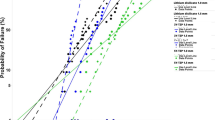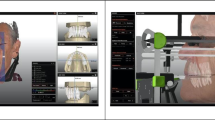Computer-aided design/manufacturing (CAD/CAM) endocrowns are commonly applied to strengthen endodontically treated teeth with too much tissue loss. Monolithic or multilayer structures may be used for this purpose. Restorations made with multilayering technique may mimic natural teeth better. The purpose of this finite elemental analysis (FEA) research was to appraise the impact of different materials and application methods on the stress effect in CAD/CAM applied endocrowns. A 3-dimensional mathematical model simulating an endodontically treated mandibular first molar was modeled. The sample was then modified to imitate the ceramic endocrown applied molar tooth. Three FEA models were then created from this main model to simulate the following endocrown structures: 1: lithium disilicate reinforced glass ceramic, 2: monolithic zirconia, 3: multi-layered glass ceramic and glass-fiber endocrown (the core structure was composed of glass-fiber while the crown is prepared by glass ceramic). The SolidWorks/CosmosWorks programs were used as structural analysis programs. The materials used in the study were accepted as homogeneous and isotropic. A 300 N load was applied to the occlusal surfaces of the restored teeth. The results of the study are presented according to the von Mises criteria. The von Mises stresses recorded at the cavity base were 0.417–0.7, 0.6–0.85, and 0.083–0.25 MPa, respectively. The multilayering technique reduced stresses as compared to the other two different designs and materials and showed similar stress distributions with the natural tooth model. Models simulating teeth with a zirconia endocrown showed the highest stresses. The multilayering technique using fiber-reinforced glass ceramic as a core and glass ceramic as a crown reduced the stresses and showed stress distributions similar to natural teeth. This technique can be used to create biomimetic restorations with a core material, which mimics dentin (glass-fiber reinforced ceramic) and crown material, which mimics enamel (glass ceramic).






Similar content being viewed by others
References
G. Aktas, H. Yerlikaya, and K. Akca, “Mechanical failure of endocrowns manufactured with different ceramic materials: an in vitro biomechanical study,” J. Prosthodont., 27, 340–346 (2018).
M. Bakke, L. Michler, and E. Moller, “Occlusal control of mandibular elevator muscles,” Eur. J. Oral Sci., 100, 284–291 (1992).
S. Belli, G. Eskitaşcioğlu, O. Eraslan, et al., “Effect of hybrid layer on stress distribution in a premolar tooth restored with composite or ceramic inlay: an FEM study,” J. Biomed. Mater. Res. B, 74, 665–668 (2005).
G. Biacchi and R. Basting, “Comparison of fracture strength of endocrowns and glass fiber post-retained conventional crowns,” Oper. Dent., 37, 130–136 (2012).
A. Bindl and W. H. Mörmann, “Clinical evaluation of adhesively placed Cerec endo-crowns after 2 years-preliminary results,” J. Adhes. Dent., 1, 255–266 (1999).
A. Bindl, B. Richter, and W. H. Mörmann, “Survival of ceramic computer-aided design/manufacturing crowns bonded to preparations with reduced macroretention geometry,” Int. J. Prosthodont., 18, 219–224 (2005).
M. Blatz, M. Vonderheide, and J. Conejo, “The effect of resin bonding on long-term success of high-strength ceramics,” J. Dent. Res., 97, 132–139 (2018).
F. Burke, G. J. P. Fleming, D. Nathanson, and P. M. Marquis, “Are adhesive technologies needed to support ceramics? An assessment of the current evidence,” J. Adhes. Dent., 4, 7–22 (2002).
M.-S. Cha, S.-W. Lee, Y.-H. Huh, et al., “Metal stain on monolithic zirconia restoration: A case report,” J. Adv. Prosthodont., 9, 138–142 (2017).
Y.-H. Chang, W.-H. Lin, W.-C. Kuo, et al., “Mechanical interactions of cuspal-coverage designs and cement thickness in a cusp-replacing ceramic premolar restoration: a finite element study,” Med. Bio. Eng. Comput., 47, 367–374 (2009).
J. Chen and L. Xu, “A finite element analysis of the human temporomandibular joint,” J. Biomech. Eng., 116, 401–407 (1994).
H. M. El-Damanhoury, R. N. Haj-Ali, and J. A. Platt, “Fracture resistance and microleakage of endocrowns utilizing three CAD-CAM blocks,” Oper. Dent., 40, 201–210 (2015).
Ö. Eraslan, G. Eskitaşcioğlu, and S. Belli, “Conservative restoration of severely damaged endodontically treated premolar teeth: a FEM study,” Clin. Oral Investig., 15, 403–408 (2011).
N. Forberger and T. N. Göhring, “Influence of the type of post and core on in vitro marginal continuity, fracture resistance, and fracture mode of lithia disilicate-based all-ceramic crowns,” J. Prosthet. Dent., 100, 264–273 (2008).
B. M. Gillen, S. W. Looney, L.-S. Gu, et al., “Impact of the quality of coronal restoration versus the quality of root canal fillings on success of root canal treatment: a systematic review and meta-analysis,” J. Endodont., 37, 895–902 (2011).
M. M. Gresnigt, M. Özcan, M. L. van den Houten, et al., “Fracture strength, failure type and Weibull characteristics of lithium disilicate and multiphase resin composite endocrowns under axial and lateral forces,” Dent. Mater., 32, 607–614 (2016).
M. A. Helal and Z. Wang, “Biomechanical assessment of restored mandibular molar by endocrown in comparison to a glass fiber post-retained conventional crown: 3D finite element analysis,” J. Prosthodont., 28, 988–996 (2017).
F. R. Homsy, M. Özcan, M. Khoury, and Z. A. Majzoub, “Marginal and internal fit of pressed lithium disilicate inlays fabricated with milling, 3D printing, and conventional technologies,” J. Prosthet. Dent., 119, 783–790 (2018).
J. Juloski, D. Apicella, and M. Ferrari, “The effect of ferrule height on stress distribution within a tooth restored with fibre posts and ceramic crown: a finite element analysis,” Dent. Mater., 30, 1304–1315 (2014).
J. R. Kelly, “Dental ceramics: what is this stuff anyway?” J. Am. Dent. Assoc., 139, S4–S7 (2008).
C.-L. Lin, Y.-H. Chang, and P.-R. Liu, “Multi-factorial analysis of a cusp-replacing adhesive premolar restoration: a finite element study,” J. Dent., 36, 194–203 (2008).
C.-L. Lin, Y.-H. Chang, and C.-A. Pa, “Estimation of the risk of failure for an endodontically treated maxillary premolar with MODP preparation and CAD/CAM ceramic restorations,” J. Endodont., 35, 1391–1395 (2009).
C. L. Lin, Y. H. Chang, C. Y. Chang, et al., “Finite element and Weibull analyses to estimate failure risks in the ceramic endocrown and classical crown for endodontically treated maxillary premolar,” Eur. J. Oral Sci., 118, 87–93 (2010).
P. Magne and U. C. Belser, “Porcelain versus composite inlays/onlays: effects of mechanical loads on stress distribution, adhesion, and crown flexure,” Int. J. Periodont. Rest., 23, 543-555 (2003).
P. Magne, N. Perakis, U. C. Belser, and I. Krejci, “Stress distribution of inlay-anchored adhesive fixed partial dentures: a finite element analysis of the influence of restorative materials and abutment preparation design,” J. Prosthet. Dent., 87, 516–528 (2002).
P. Magne, A. Versluis, and W. H. Douglas, “Rationalization of incisor shape: experimental-numerical analysis,” J. Prosthet. Dent., 81, 345–355 (1999).
J. M. Mendez Carames, A. D. Sola Pereira da Mata, D. N. da Silva Marques, and H. C. de Oliveira Francisco, “Ceramic-veneered zirconia frameworks in full-arch implant rehabilitations: A 6-month to 5-year retrospective cohort study,” Int. J. Oral Maxillofac. Implants, 31, 1407–1414 (2016).
S. Miura, S. Kasahara, S. Yamauchi, and H. Egusa, “Effect of finish line design on stress distribution in bilayer and monolithic zirconia crowns: a three-dimensional finite element analysis study,” Eur. J. Oral Sci., 126, 159–165 (2018).
S. M. Morgano, “Restoration of pulpless teeth: application of traditional principles in present and future contexts,” J. Prosthet. Dent., 75, 375–380 (1996).
T. Otto, “Computer-aided direct all-ceramic crowns: preliminary 1-year results of a prospective clinical study,” Int. J. Periodont. Rest., 24, 446–455 (2004).
P. Pissis, “Fabrication of a metal-free ceramic restoration utilizing the monobloc technique,” Pract. Periodontics Aesthet Dent., 7, 83–94 (1995).
S. M. Reich, M. Wichmann, H. Rinne, and A. Shortall, “Clinical performance of large, all-ceramic CAD/CAM-generated restorations after three years: a pilot study,” J. Am. Dent. Assoc., 135, 605–612 (2004).
C.-L. Lin, Y.-H. Chang, S.-K. Hsieh, and W.-J. Chang, “Estimation of the failure risk of a maxillary premolar with different crack depths with endodontic treatment by computer-aided design/computer-aided manufacturing ceramic restorations,” J. Endodont., 39, 375–379 (2013).
G. T. Rocca, C. M. Saratti, A. Poncet, et al., “The influence of FRCs reinforcement on marginal adaptation of CAD/CAM composite resin endocrowns after simulated fatigue loading,” Odontology, 104, 220–232 (2016).
A. Kishen, “Mechanisms and risk factors for fracture predilection in endodontically treated teeth,” Endodont. Topics, 13, 57–83 (2006).
A. Lanza, R. Aversa, S. Rengo, et al., “3D FEA of cemented steel, glass and carbon posts in a maxillary incisor,” Dent. Mater., 21, 709–715 (2005).
L. Shamseddine, R. Mortada, K. Rifai, and J. J. Chidiac, “Fit of pressed crowns fabricated from two CAD-CAM wax pattern process plans: A comparative in vitro study,” J. Prosthet. Dent., 118, 49–54 (2017).
M. Toparli, N. Gokay, and T. Aksoy, “Analysis of a restored maxillary second premolar tooth by using three-dimensional finite element method,” J. Oral Rehabil., 26, 157–164 (1999).
D. Tortopidis, M. Lyons, R. Baxendale, and W. Gilmour, “The variability of bite force measurement between sessions, in different positions within the dental arch,” J. Oral Rehabil., 25, 681–686 (1998).
J. P. M. Tribst, A. M. O. Dal Piva, C. F. L. Madruga, et al., “Endocrown restorations: Influence of dental remnant and restorative material on stress distribution,” Dent. Mater., 34, 1466–1473 (2018).
J. W. van Dijken, L. Hasselrot, A. Ormin, and A. L. Olofsson, “Restorations with extensive dentin/enamel-bonded ceramic coverage. A 5-year follow-up,” Eur. J. Oral Sci., 109, 222–229 (2001).
V. Veselinovic, A. Todorovic, D. Lisjak, and V. Lazic, “Restoring endodontically treated teeth with all-ceramic endo-crowns: case report,” Stomatoloski Glasnik Srbije, 55, 54–64 (2008).
R. C. Wheeler, Dental Anatomy, Physiology, and Occlusion, Saunders (1974).
Ö. Küçük, O. Eraslan, G. Eskitascioglu, and S. Belli, “Effect of loading direction, crown coverage, and adjacent teeth on stresses in post-restored premolars,” Strength Mater, 52, No. 2, 317–324 (2020).
Acknowledgment
This study was supported in part by the Scientific Research Project Coordination Center (BAP) of Selcuk University, Konya, Turkey.
Author information
Authors and Affiliations
Corresponding author
Additional information
Translated from Problemy Prochnosti, No. 5, pp. 139 – 146, September – October, 2020.
Rights and permissions
About this article
Cite this article
Eskitaşçioğlu, M., Küçük, O., Eskitaşçioğlu, G. et al. The Effect of Different Materials and Techniques on Stress Distribution in CAD/CAM Endocrowns. Strength Mater 52, 812–819 (2020). https://doi.org/10.1007/s11223-020-00235-1
Received:
Published:
Issue Date:
DOI: https://doi.org/10.1007/s11223-020-00235-1




